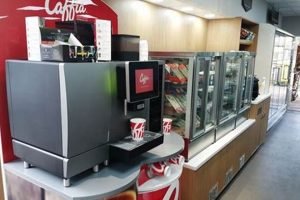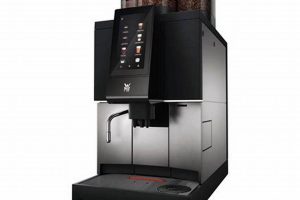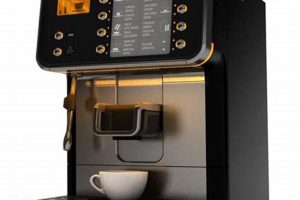Automated beverage dispensing units designed for high-traffic locations represent a significant sector within the food and beverage service industry. These devices offer a self-service solution for providing hot and cold coffee-based drinks in settings such as offices, factories, hospitals, and public transportation hubs. Their functionality ranges from simple drip coffee to complex espresso-based beverages, often including options for customization such as milk, sugar, and flavorings.
The prevalence of these systems stems from their ability to provide convenient and readily available access to coffee, enhancing productivity and satisfaction among users. Historically, they have evolved from basic mechanical dispensers to sophisticated, digitally controlled units capable of tracking inventory, processing payments via various methods (including mobile payment), and transmitting data for remote monitoring and maintenance. This evolution has led to increased efficiency and reduced operational costs for businesses.
The following sections will explore the various aspects of these automated coffee solutions, encompassing types of machines, operational considerations, cost analysis, technological advancements, and factors influencing purchase decisions for businesses seeking to implement or upgrade their beverage service offerings.
Optimizing Commercial Coffee Vending Machine Operations
The following are crucial considerations for maximizing the profitability and efficiency of automated coffee dispensing operations. These tips address key areas impacting user satisfaction, operational costs, and long-term sustainability.
Tip 1: Routine Maintenance is Paramount. Regular cleaning and preventative maintenance schedules are essential. Neglecting these tasks can lead to machine malfunction, decreased beverage quality, and increased repair costs. A log should be maintained to track maintenance activities and identify potential issues early.
Tip 2: Prioritize High-Quality Ingredients. The quality of the coffee beans, milk, and other ingredients directly impacts the taste and overall customer satisfaction. Investing in premium ingredients justifies a higher price point and fosters customer loyalty. Consistent ingredient quality also minimizes machine clogging and operational disruptions.
Tip 3: Implement Effective Inventory Management. Accurate monitoring of ingredient levels and sales data is crucial for optimizing stock levels and minimizing waste. Implement a system for tracking inventory in real-time and forecast demand to prevent stockouts and overstocking. Data analysis can reveal popular beverages and consumption patterns.
Tip 4: Diversify Payment Options. Accommodate a range of payment methods, including cash, credit/debit cards, and mobile payment options. Limiting payment options restricts potential sales and inconveniences customers. Acceptance of multiple payment forms broadens accessibility and increases revenue opportunities.
Tip 5: Offer Customizable Beverage Options. Allow users to customize their drinks with various options, such as different coffee strengths, milk types, and flavorings. Customization enhances the user experience and caters to individual preferences. This flexibility differentiates the machine and potentially commands a premium price.
Tip 6: Secure Strategic Placement. The location of these units significantly influences their profitability. Position them in high-traffic areas with limited access to alternative beverage options. Consider factors such as proximity to employee work areas, public transportation hubs, and waiting areas. Optimal placement maximizes visibility and accessibility.
Tip 7: Leverage Data Analytics for Optimization. Utilize data collected by modern units to analyze sales trends, peak usage times, and popular beverage choices. This information can inform inventory management, pricing strategies, and marketing campaigns. Data-driven decisions optimize efficiency and increase revenue.
Implementing these operational strategies will lead to improved performance and enhanced customer satisfaction. Consistent application ensures a cost-effective and reliable coffee dispensing solution.
Moving forward, the discussion will address factors to consider when selecting the appropriate dispensing system for a particular business environment.
1. Selection
The selection process represents a critical phase in deploying automated coffee dispensing units. A well-informed decision, aligned with specific organizational needs and user preferences, directly impacts the long-term success and return on investment of such systems.
- Beverage Variety and Capacity
The range of beverages offered and the machine’s capacity to meet peak demand are paramount. Consider the types of beverages preferred by the target user base (e.g., espresso-based drinks, drip coffee, tea) and choose a machine capable of delivering the required volume efficiently. Overestimation leads to unnecessary capital expenditure; underestimation results in user dissatisfaction and lost revenue.
- Technological Integration and User Interface
Modern units often incorporate advanced features such as touchscreen interfaces, mobile payment options, and remote monitoring capabilities. The ease of use and integration with existing technological infrastructure are important considerations. A complex or unreliable user interface can deter adoption, while a lack of data connectivity limits the ability to optimize inventory and maintenance schedules.
- Physical Footprint and Environmental Considerations
The available space and environmental conditions of the intended location influence the selection process. Compact models are suitable for locations with limited space, while robust units are necessary for high-traffic areas. Energy efficiency and compliance with environmental regulations should also factor into the decision. Inadequate space hinders accessibility; disregarding environmental impact creates reputational risks.
- Maintenance Requirements and Support Availability
The level of maintenance required and the availability of technical support directly impact operational costs and downtime. Machines with complex mechanisms necessitate specialized expertise, increasing maintenance expenses. The availability of responsive and reliable support services minimizes disruptions and ensures the long-term viability of the investment. Frequent breakdowns and lack of support erode user confidence and profitability.
The facets outlined above demonstrate the multifaceted nature of the selection process. By carefully evaluating beverage offerings, technological integration, physical constraints, and maintenance considerations, businesses can choose a automated coffee dispensing system that aligns with their specific needs and maximizes their return on investment. Neglecting these factors often results in suboptimal performance, increased costs, and user dissatisfaction.
2. Operation
The efficient and consistent operation of automated coffee dispensing units is paramount to their success and profitability. Proper operation directly influences beverage quality, customer satisfaction, and overall machine lifespan. The fundamental operational components include ingredient loading and management, drink dispensing mechanisms, payment processing, and system monitoring. Each of these aspects contributes to the reliable provision of beverages and the minimization of downtime.
Failures in any of these operational areas can have cascading negative effects. For example, insufficient inventory management leads to stockouts, frustrating customers and resulting in lost revenue. Malfunctions in the dispensing mechanism result in inconsistent beverage quality, potentially damaging the unit’s reputation. Inadequate maintenance of payment systems can cause transaction errors, further contributing to customer dissatisfaction. A comprehensive understanding of these dependencies is crucial for operators to proactively address potential issues and maintain optimal performance. Consider a high-traffic location where operational inefficiencies in refilling ingredients resulted in extended periods of machine downtime. The revenue lost and user frustration directly underscore the critical impact of consistent operation.
In conclusion, effective operation is not merely a routine task; it is a determinant of the automated coffee unit’s success. Focusing on proactive maintenance, meticulous inventory control, reliable dispensing systems, and secure payment processing directly translates to improved customer experience and profitability. Neglecting these critical operational facets risks compromising the entire investment, leading to increased costs and diminished returns. The long-term viability of these systems relies on a commitment to consistent and effective operational practices.
3. Maintenance
The ongoing performance and longevity of commercial coffee vending machines are inextricably linked to consistent and comprehensive maintenance practices. These practices are not merely corrective; they are preventative measures that ensure operational efficiency, minimize downtime, and safeguard the initial investment.
- Preventative Component Replacement
Scheduled replacement of wear-prone components, such as seals, filters, and dispensing nozzles, mitigates the risk of sudden failures. Proactive replacement reduces emergency repairs and ensures consistent beverage quality. For example, replacing water filters at recommended intervals prevents mineral buildup, preserving the taste of the coffee and preventing damage to heating elements. Failure to adhere to preventative replacement schedules can lead to costly repairs and extended periods of machine unavailability.
- Regular Cleaning and Sanitization
Thorough cleaning of internal components and external surfaces prevents the accumulation of coffee residue, mold, and bacteria. Regular sanitization maintains hygiene standards and ensures the safety of the beverages dispensed. Neglecting cleaning can result in unpleasant odors, compromised taste, and potential health risks for consumers. Routine cleaning protocols should include dismantling and cleaning brewing units, milk frothers, and dispensing mechanisms.
- Calibration and Adjustment of System Parameters
Periodic calibration of brewing parameters, such as water temperature, pressure, and grind size, ensures consistent beverage quality and optimal extraction. Adjustments to dispensing volumes guarantee accurate serving sizes. Deviations in these parameters result in inconsistent taste profiles and dissatisfied customers. Regular calibration optimizes resource utilization and minimizes waste.
- Inspection and Testing of Electrical Components
Routine inspection and testing of electrical wiring, connections, and safety devices prevents electrical hazards and ensures safe operation. Identifying and addressing potential issues, such as frayed wires or faulty switches, minimizes the risk of electrical fires and equipment damage. Neglecting electrical maintenance can create dangerous operating conditions and lead to costly repairs.
The multifaceted nature of maintenance underscores its importance in maintaining the viability of automated coffee solutions. Adherence to rigorous maintenance schedules and protocols protects the investment, ensures consistent beverage quality, and promotes customer satisfaction. By prioritizing maintenance, businesses can maximize the operational lifespan and profitability of commercial coffee vending machines, transforming them into reliable and valuable assets.
4. Technology
The integration of advanced technology is a defining characteristic of modern units and a primary driver of their increasing efficiency and functionality. The evolution from basic mechanical dispensers to digitally controlled, data-driven systems is attributable to advancements in several key technological areas. These encompass embedded systems, sensor technology, data analytics, and secure payment processing.
Embedded systems enable precise control over brewing parameters, ensuring consistent beverage quality across various selections. Sensor technology monitors ingredient levels, identifies potential malfunctions, and facilitates preventative maintenance. Data analytics provide insights into user preferences, sales trends, and machine performance, enabling operators to optimize inventory management, pricing strategies, and service schedules. Secure payment processing integrates cashless options, increasing user convenience and expanding revenue opportunities. For example, telemetry systems within devices allow remote monitoring of ingredient levels and machine status, triggering automatic restocking alerts or maintenance requests, significantly reducing downtime. Modern interfaces increase user experience with touchscreen features.
Ultimately, the integration of these technologies is not merely a feature enhancement; it represents a fundamental shift in how coffee dispensing systems operate and are managed. This evolution leads to increased efficiency, reduced operational costs, and improved customer satisfaction. The continued adoption of advanced technologies is essential for the long-term viability and success of the vending machine industry.
5. Cost
The economic viability of commercial coffee vending machines is fundamentally linked to a comprehensive understanding of all associated costs. Accurately assessing these expenditures is essential for determining profitability and making informed investment decisions.
- Initial Capital Investment
The initial purchase price of the machine represents a significant upfront cost. This varies widely based on factors such as brand, capacity, features (e.g., touchscreen interface, cashless payment options), and brewing technology (e.g., bean-to-cup, instant). Selecting a unit with advanced features may increase the initial investment but can potentially yield higher returns through increased sales and customer satisfaction. For example, a high-capacity machine suitable for a large office building represents a substantially higher initial cost than a smaller unit designed for a small retail location.
- Operating Expenses
Ongoing operating costs include the price of coffee beans, milk, sugar, cups, and other consumables. Energy consumption represents another significant expense, particularly for machines with heating elements and refrigeration systems. Maintenance and repair costs, including preventative maintenance, replacement parts, and labor, also contribute to operating expenses. Effective inventory management and preventative maintenance are critical for minimizing these costs.
- Installation and Setup Fees
Installation fees may include plumbing connections, electrical work, and network setup. The complexity of the installation depends on the machine’s features and the existing infrastructure of the location. Some vendors offer installation services as part of the purchase price, while others charge separately. Overlooking these costs can lead to budget overruns.
- Depreciation and Amortization
The value of the machine depreciates over time due to wear and tear and technological obsolescence. Accounting for depreciation allows businesses to accurately assess the total cost of ownership and calculate return on investment. The depreciation schedule depends on the machine’s estimated lifespan and the accounting methods used. Properly accounting for depreciation ensures a realistic assessment of long-term profitability.
The integration of these cost elements into a comprehensive financial model is crucial for determining the feasibility of deploying commercial coffee vending machines. By carefully analyzing capital expenditures, operating expenses, installation costs, and depreciation, businesses can make informed decisions that maximize profitability and ensure a sustainable return on investment. The careful management of these costs can transform an capital investment into a profit.
6. Revenue
Revenue generation constitutes a critical performance indicator for automated coffee dispensing units. The financial success of these systems hinges on several key factors influencing sales volume and pricing strategies. Factors include location, beverage quality, machine features, and pricing. Optimal placement in high-traffic areas maximizes potential customers, while consistent beverage quality fosters repeat business. Integrating advanced features such as cashless payment options and customizable drink selections enhances user experience and can command premium pricing. Pricing strategies must balance profitability with affordability, considering local market conditions and competitive offerings. Successfully managing these elements directly impacts the revenue generated by the coffee dispensing unit.
Real-world examples illustrate the practical significance of understanding the revenue-generating mechanisms of these machines. Consider a unit located in a busy transportation hub. The high volume of potential customers justifies a slightly higher price point due to the convenience offered. Implementing a loyalty program, such as offering a free drink after a certain number of purchases, incentivizes repeat business and increases revenue. Conversely, a unit located in a less populated area may require more competitive pricing and targeted marketing efforts to attract customers and generate sufficient revenue. These examples underscore the importance of adapting revenue strategies to specific market conditions.
In conclusion, revenue is a core component of automated coffee unit operations. Challenges to sustained revenue streams include fluctuating ingredient costs, technological obsolescence, and increasing competition from alternative beverage options. Understanding the interplay between location, beverage quality, pricing, and customer loyalty is crucial for maximizing revenue and ensuring the long-term financial viability of these systems. Addressing these challenges through strategic planning and proactive adaptation allows businesses to capitalize on the revenue-generating potential of automated coffee solutions. Revenue models must be dynamic.
Frequently Asked Questions
The following questions address common inquiries regarding the selection, operation, and maintenance of automated coffee dispensing solutions. The information provided aims to offer clarity and guidance for businesses considering deploying or optimizing such systems.
Question 1: What factors determine the optimal location for a commercial coffee vending machine?
High-traffic areas with limited access to alternative beverage options generally represent the most suitable locations. Proximity to employee break rooms, public transportation hubs, and waiting areas are also key considerations. Careful assessment of pedestrian flow and user demographics is essential for maximizing sales potential.
Question 2: How frequently should a commercial coffee vending machine undergo maintenance?
Preventative maintenance schedules should be established based on manufacturer recommendations and usage volume. Daily cleaning of external surfaces and dispensing areas is essential. Internal components should be cleaned and sanitized weekly. Component replacement, such as water filters and seals, should occur quarterly or biannually, depending on usage. Consistent maintenance minimizes downtime and ensures beverage quality.
Question 3: What types of payment options should a commercial coffee vending machine support?
A diverse range of payment options enhances user convenience and maximizes sales opportunities. Cash acceptance is a standard requirement. Credit and debit card readers are increasingly important, as is mobile payment compatibility (e.g., Apple Pay, Google Pay). Offering multiple payment methods broadens accessibility and accommodates user preferences.
Question 4: What are the primary benefits of integrating telemetry into a commercial coffee vending machine?
Telemetry systems enable remote monitoring of machine status, ingredient levels, and sales data. This allows for proactive inventory management, predictive maintenance, and real-time troubleshooting. Telemetry reduces downtime, optimizes operational efficiency, and improves customer service.
Question 5: How can a business ensure the quality of coffee dispensed by a commercial coffee vending machine?
Utilizing high-quality coffee beans and ingredients is paramount. Implementing a regular maintenance schedule, including cleaning and calibration, ensures consistent brewing parameters. Monitoring water quality and using appropriate filtration systems also contributes to optimal taste. Consistent attention to these details maintains beverage quality.
Question 6: What is the typical lifespan of a commercial coffee vending machine?
The lifespan varies depending on machine quality, usage volume, and maintenance practices. Generally, a well-maintained commercial unit can operate effectively for 5-7 years. However, advancements in technology may necessitate upgrades or replacements sooner to maintain competitiveness and meet evolving user expectations.
In summary, careful planning, consistent maintenance, and strategic utilization of technology are key factors in maximizing the value of automated coffee systems. These FAQs provide a foundation for informed decision-making in deploying and managing these units.
Moving forward, practical considerations of commercial coffee vending machines can offer improved performance.
Conclusion
This exploration has dissected various facets of commercial coffee vending machines, underscoring their operational intricacies, technological underpinnings, and economic considerations. From strategic selection and meticulous maintenance to revenue optimization and the integration of advanced technology, each element contributes to the overall success and long-term viability of these automated beverage solutions. Comprehending these aspects is paramount for businesses seeking to leverage the benefits of these systems effectively.
The future trajectory of commercial coffee vending machines is intertwined with continued technological innovation and evolving consumer preferences. Businesses must prioritize continuous adaptation, embrace data-driven decision-making, and remain committed to providing high-quality, convenient, and customizable beverage experiences. By embracing these principles, organizations can harness the full potential of automated coffee dispensing, transforming these systems into valuable assets that enhance productivity, customer satisfaction, and profitability.







